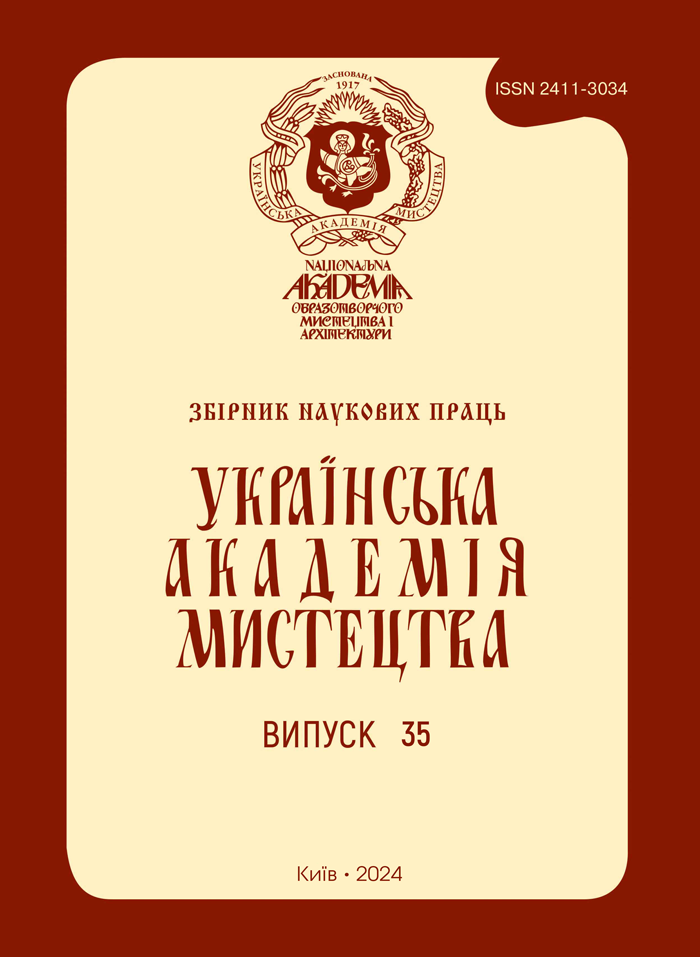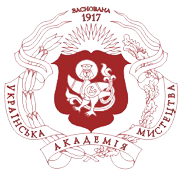SUMMER PRACTICE IN KANEV AND THE TRADITIONS OF UKRAINIAN PLEIN-AIR PAINTING IN THE CREATIVE EXPERIENCE OF THE KYIV STATE ART INSTITUTE OF ART (1946–1989)
DOI:
https://doi.org/10.32782/2411-3034-2024-35-12Keywords:
visual arts NAFAA, plein air, summer practice, KanivAbstract
The purpose of this article is to explore the significance of summer artistic and creative practice, which students of the academy underwent from 1946 to 1989 in Kaniv, for the educational process of KSAI (now NAFAA). The main research method is the analysis of oral and written memories of participants in Kaniv practices (V. Barinova, V. Vyrodova-Hotye, O. Solovya, A. Yalansky), as well as the consideration of available publications in scientific and popular editions. Generalization of the collected materials provides grounds for asserting a comprehensive understanding of the significance and role of plein air practices in Kaniv in the educational and creative processes of several generations of students and teachers of KSAI (now NAFAA). Considering the demands placed on art at certain historical moments, we analyzed the artistic preferences of teachers and highlighted their educational experience gained during the studied period, as well as identified the need for summer practice at NAFAA. Since the 1930s, the Kyiv State Art Institute has been conducting annual plein air student practices in Kaniv. It is known that in 1933–1934 there was a restructuring of the educational process. The experience of Kaniv practice was invaluable. Despite not all students having a penchant for plein air work, Kaniv’s summer practice played a very important role in the formation of young artists, in their selfawareness as independent individuals. It is important to note that plein air practice specifically stimulated a more liberated and innovative approach to the creative process, less constrained by the normative requirements of the socialist realist method. In practice, even first-year students engaged in creative exploration. This became especially possible in the late 1970s to the first half of the 1980s. Compositional rethinking of natural impressions as plein air landscapes and setups prompted formal and content-related searches. Plein air practice primarily opens up freedom of thought, taking students out of the confined space of the workshop, beyond which, in contact with real life, the process of expanding and deepening their professional vision took place. As artists, students returned to the worksho ps in the fall as entirely different individuals. The obtained research results can be used to modernize the educational process, during the search for new effective forms that preserve the positive heritage of previous decades. Conclusions. Summer practices in Kaniv over several decades have significantly influenced the artistic environment of Ukraine. Plein air practice is an integral part of the educational process at NAFAA, important for changing the environment, as well as for rethinking the knowledge gained during the first and second semesters.
References
Академічна виставка НХМУ. Антиквар. 2012. № 11. С. 6.
Денисов В. Етюдна виставка студентів. Українська академія мистецтва : дослідн. та наук.- метод. пр. Київ, 2011. Вип. 18. С. 33–39.
Григорьев С. Спогади : мемуари художника. Київ : Шк. світ, 2010. 84 с.
Григорьева Г. У моїх роботах живе пам’ять про Канів. Антиквар. 2012. № 11. С. 52–58.
Шалімова-Пузиркова М. Київський художній інститут в евакуації (1941–1944 рр.). Українська академія мистецтва : дослідн. та наук.-метод. пр. Київ, 2007. Вип. 14. С. 163–175.
Малаков Д. Повоєння. Спогади киянина : монографія. Київ, 2013. 304 с.
Виродова-Готьє В. [Спогади про Канів]: інтерв’ю з В.Г. Виродовою-Готьє / спілкувався Храпачов Олександр. [Київ], 2023. 8 арк. Рукопис.
Красний І. Літня навчальна практика з живопису на 1 курсі графічного факультету КДХІ. Українська академія мистецтва : дослідн. та наук.-метод. пр. Київ, 2011. Вип. 18. С. 22–24.
Піаніда Б. Федір Кричевський – художник і педагог. Українська академія мистецтва : дослідн. та наук.-метод. пр. Київ, 2011. Вип. 18. С. 40–46.
Яланський А. Про формування у студентів колористичного відчуття в умовах пленеру. Українська академія мистецтва : дослідн. та наук.-метод. пр. Київ, 2011. Вип. 18. С. 16–21.
Негода Б. Пленерна практика студентів у вищих навчальних закладах. Мистецтвознавство України. 2007. № 8. С. 382–389.
Левитська І. Все моє з собою. Київ : Софія-А, 2004.
Малаков Д. Студентська практика Георгія Малакова. Українська академія мистецтва : дослідн. та наук.-метод. пр. Київ, 2011. Вип. 18. С. 25–33.
Яланський А. [канівська практика в освітньому процесі КДХІ]: інтерв’ю з А. В. Яланським / спілкувався Храпачов Олександр. [Київ], 2022. 8 арк. Рукопис.
Юхимець Г. На шляху до професійної майстерності. Образотворче мистецтво. 1971. № 3. С. 16–17.
Яблонська Тетяна : щоденники, спогади, роздуми. Київ : Родовід, 2020.
Баринова-Кулеба В.І. [Спогади про Канів]: інтерв’ю з В.І. Бариновою-Кулебою / спілкувався Храпачов Олександр. [Київ], 2023. 1 арк. Рукопис.
Павельчук І. Традиції українського народного мистецтва в живописних композиціях Тетяни Яблонської. Актуальні проблеми мистецької практики і мистецтвознавчої науки. Мистецькі обрії. 2012. № 4 (14/15). С. 106–113.
Тельцов М. Громадянськість творчості Василя Гуріна. Образотворче мистецтво. 1994. № 1. С. 29–30.
Чебикін А. Пленер як різновид мистецької школи. Українська академія мистецтва : дослідн. та наук.-метод. пр. Київ, 2011. Вип. 18. С. 7–8.
Яланський А. Предметна зображувальність як одне із завдань літньої практики. Українська академія мистецтва : дослідн. та наук.-метод. пр. Київ, 2010. Вип. 17. С. 123–128.




